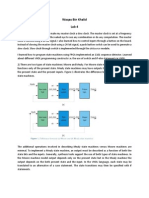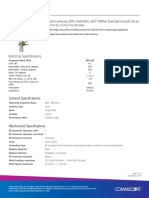Modulo N Counter
Uploaded by
Shankar RaoModulo N Counter
Uploaded by
Shankar Rao---------------------------------------------------------------------------------- Company: -- Engineer: --- Create Date: 22:24:17 09/19/2010 -- Design Name: -- Module Name: mod_n_counter_001 - arch -- Project
Name: -- Target Devices: -- Tool versions: -- Description: --- Dependencies: --- Revision: -- Revision 0.01 - File Created -- Additional Comments: ---------------------------------------------------------------------------------library IEEE; use IEEE.STD_LOGIC_1164.ALL; use IEEE.numeric_std.all; ---- Uncomment the following library declaration if instantiating ---- any Xilinx primitives in this code. --library UNISIM; --use UNISIM.VComponents.all; entity mod_n_counter_001 is generic ( g_counter_bits g_modulus integer:= 7 port ( reset : in ); clk std_logic; : in std_logic; : integer:= 3; :
o_tick : out std_logic ); end mod_n_counter_001; architecture arch of mod_n_counter_001 is signal i_counter_now downto 0); signal i_counter_next begin process(clk, reset) begin : unsigned(g_counter_bits-1 : unsigned(g_counter_bits-1 downto 0);
if (reset = '1') then i_counter_now <= (others=>'0'); elsif (clk'event and clk = '1') then i_counter_now <= i_counter_next; end if; end process; i_counter_next <= (others => '0') when i_counter_now = (g_modulus-1) else (i_counter_now+1); o_tick <= end arch; '1' when i_counter_now = g_modulus-1 else '0';
---------------------------------------------------------------------------------- Company: -- Engineer: --- Create Date: 22:24:17 09/19/2010 -- Design Name: -- Module Name: mod_n_counter_en_001 - arch -- Project Name: -- Target Devices: -- Tool versions: -- Description: --- Dependencies: --- Revision: -- Revision 0.01 - File Created -- Additional Comments: ---------------------------------------------------------------------------------library IEEE; use IEEE.STD_LOGIC_1164.ALL; use IEEE.numeric_std.all; ---- Uncomment the following library declaration if instantiating ---- any Xilinx primitives in this code. --library UNISIM; --use UNISIM.VComponents.all; entity mod_n_counter_en_001 is generic ( g_counter_bits g_modulus integer:= 7 port ( reset : in ); clk std_logic; i_en : in std_logic; : integer:= 3; :
: in std_logic;
o_tick : out std_logic ); end mod_n_counter_en_001; architecture arch of mod_n_counter_en_001 is signal i_counter_now downto 0); signal i_counter_next begin process(clk, reset) : unsigned(g_counter_bits-1 : unsigned(g_counter_bits-1 downto 0);
begin if (reset = '1') then i_counter_now <= (others=>'0'); elsif (clk'event and clk = '1') and i_en = '1' then i_counter_now <= i_counter_next; end if; end process; i_counter_next <= (others => '0') when i_counter_now = (g_modulus-1) else (i_counter_now+1); o_tick <= end arch; '1' when i_counter_now = (g_modulus-1) else '0';
Schematic diagram for a modulo n counter
A synthesizable delay generator instead of 'wait for' statement
There are many situations in which you may need to activate a process after a certain delay or at fixed time intervals.If you want to do simulation alone for your design then you can simply use "wait for" statement to call a delay routine.But this keyword is not synthesizable.So what will you do in such situations? A simple delay routine,which is synthesizable, can be designed using the properties of a "MOD-n counter".A MOD-n counter can be used to generate a frequency of (f / n) using a frequency 'f'. The code for generating such a delay is given below: library IEEE; use IEEE.STD_LOGIC_1164.ALL; use IEEE.STD_LOGIC_ARITH.ALL; use IEEE.STD_LOGIC_UNSIGNED.ALL; entity test is port (clk : in std_logic; --delay to be generated. a : in std_logic_vector(31 downto 0); --this is a pulse to notify that time interval equal to delay is over. flag : out std_logic ); end test; architecture Behavioral of test is signal count :integer:=0; begin process(clk) begin if(clk'event and clk='1') then count <= count +1; --increment counter. end if; --see whether counter value is reached,if yes set the flag. if(count = conv_integer(a)) then count <= 0; flag <='1'; else flag <='0'; end if; end process; end Behavioral;
The module has 2 inputs0- clock and a vector which determines the amount of delay to be generated. Say you want a 100 ns delay.Now say your clk frequency is 1 GHz,that is your clock period is 1 ns.So the value of 'a' should be equal to (100 / 1) = 100.When the counter counts till 100, it sends a pulse to notify.Below is an example of how to do it : ---- a program which uses a delay routine of 100 ns. architecture Behavioral of your_module is signal flag : std_logic :='0'; signal delay_needed : std_logic_vector(31 downto 0); delay_needed <= "00000000000000000000000001100100"; --100 in binary. inst_delay : test port map(clk,delay_needed,flag); begin process(flag) begin if(flag'event and flag='1') then output <= calculated; -- this line is executed only once in 100 ns. end if; end process; end Behavioral; This small code can be used under many situations,like : 1) To run some parts of your design at a lesser clock frequency than your system clock. 2) To create a delay between some of the processes. The range of delay values can be increased by increasing the size of 'a'.Also the maximum error in the delay produced is equal to time period of input clock.
You might also like
- MSC Computer Science With Data AnalyticsNo ratings yetMSC Computer Science With Data Analytics23 pages
- Lecture 7 - Sequential Design II Re-Usable Components in VHDLNo ratings yetLecture 7 - Sequential Design II Re-Usable Components in VHDL16 pages
- The VHDL Code For 4 Bit Johnson Counter IsNo ratings yetThe VHDL Code For 4 Bit Johnson Counter Is3 pages
- Computer Architecture & Digital Hardware Design (ECD09) : (Practical File)No ratings yetComputer Architecture & Digital Hardware Design (ECD09) : (Practical File)18 pages
- Example VHDL Entity - 0 To 9 Counter: VHDL Model VHDL Test BenchNo ratings yetExample VHDL Entity - 0 To 9 Counter: VHDL Model VHDL Test Bench1 page
- Group Members: - Shermeen Tajammal (FA17-BEE-025) - Adeela Bashir (FA17-BEE-064) - Sana Nasir (FA17-BEE-091)No ratings yetGroup Members: - Shermeen Tajammal (FA17-BEE-025) - Adeela Bashir (FA17-BEE-064) - Sana Nasir (FA17-BEE-091)12 pages
- Tugas8 - 2210191006 - Filosofi Dwibakti - LapsemNo ratings yetTugas8 - 2210191006 - Filosofi Dwibakti - Lapsem23 pages
- Digital Integrated Circuits Lab: Practical FILENo ratings yetDigital Integrated Circuits Lab: Practical FILE55 pages
- Lab9 - Counters, Timers, and Real-Time ClockNo ratings yetLab9 - Counters, Timers, and Real-Time Clock6 pages
- Eee 270 Advanced Topics in Logic Design More On FSMDS: References/CreditsNo ratings yetEee 270 Advanced Topics in Logic Design More On FSMDS: References/Credits27 pages
- VHDL LAB 10 FSM Code Solution and Test BenchNo ratings yetVHDL LAB 10 FSM Code Solution and Test Bench11 pages
- Instant Download For Solution Manual For VHDL For Engineers Kenneth L. Short 2024 Full Chapters in PDF100% (3)Instant Download For Solution Manual For VHDL For Engineers Kenneth L. Short 2024 Full Chapters in PDF49 pages
- Active Learning Assignment FOR The Subject "Microprocessor & Interfacing"No ratings yetActive Learning Assignment FOR The Subject "Microprocessor & Interfacing"33 pages
- VD-LINE-WP57-SUB-ATM-0001-017 - ERECTION AND INSTALLATION PROCEDURE ATM TANK - Rev.1No ratings yetVD-LINE-WP57-SUB-ATM-0001-017 - ERECTION AND INSTALLATION PROCEDURE ATM TANK - Rev.118 pages
- Secure Message Transmission During Handoff in Wireless Mesh NetworksNo ratings yetSecure Message Transmission During Handoff in Wireless Mesh Networks54 pages
- OBE Syllabus in Computer Systems Servicing NC II100% (1)OBE Syllabus in Computer Systems Servicing NC II7 pages
- Procedures For Excavation, Pipe Laying & Jointing - Mechanical Engineering Notes & Pipe Laying ProceduresNo ratings yetProcedures For Excavation, Pipe Laying & Jointing - Mechanical Engineering Notes & Pipe Laying Procedures15 pages
- Hon-PTZ-4MP-I-HIP4PI-S23X-Datasheet FinalNo ratings yetHon-PTZ-4MP-I-HIP4PI-S23X-Datasheet Final4 pages
- VivaValet Services and Benefits It OffersNo ratings yetVivaValet Services and Benefits It Offers3 pages
- AIX Operating System Hardening ProceduresNo ratings yetAIX Operating System Hardening Procedures10 pages
- Tulasi: Technical Skills On Devops ToolsNo ratings yetTulasi: Technical Skills On Devops Tools4 pages
- Artificial Intelligence (AI) Literacy in Early Childhood Education: The Challenges and OpportunitiesNo ratings yetArtificial Intelligence (AI) Literacy in Early Childhood Education: The Challenges and Opportunities66 pages
- Lecture 7 - Sequential Design II Re-Usable Components in VHDLLecture 7 - Sequential Design II Re-Usable Components in VHDL
- Computer Architecture & Digital Hardware Design (ECD09) : (Practical File)Computer Architecture & Digital Hardware Design (ECD09) : (Practical File)
- Example VHDL Entity - 0 To 9 Counter: VHDL Model VHDL Test BenchExample VHDL Entity - 0 To 9 Counter: VHDL Model VHDL Test Bench
- Group Members: - Shermeen Tajammal (FA17-BEE-025) - Adeela Bashir (FA17-BEE-064) - Sana Nasir (FA17-BEE-091)Group Members: - Shermeen Tajammal (FA17-BEE-025) - Adeela Bashir (FA17-BEE-064) - Sana Nasir (FA17-BEE-091)
- Eee 270 Advanced Topics in Logic Design More On FSMDS: References/CreditsEee 270 Advanced Topics in Logic Design More On FSMDS: References/Credits
- Instant Download For Solution Manual For VHDL For Engineers Kenneth L. Short 2024 Full Chapters in PDFInstant Download For Solution Manual For VHDL For Engineers Kenneth L. Short 2024 Full Chapters in PDF
- Active Learning Assignment FOR The Subject "Microprocessor & Interfacing"Active Learning Assignment FOR The Subject "Microprocessor & Interfacing"
- VD-LINE-WP57-SUB-ATM-0001-017 - ERECTION AND INSTALLATION PROCEDURE ATM TANK - Rev.1VD-LINE-WP57-SUB-ATM-0001-017 - ERECTION AND INSTALLATION PROCEDURE ATM TANK - Rev.1
- Secure Message Transmission During Handoff in Wireless Mesh NetworksSecure Message Transmission During Handoff in Wireless Mesh Networks
- Procedures For Excavation, Pipe Laying & Jointing - Mechanical Engineering Notes & Pipe Laying ProceduresProcedures For Excavation, Pipe Laying & Jointing - Mechanical Engineering Notes & Pipe Laying Procedures
- Artificial Intelligence (AI) Literacy in Early Childhood Education: The Challenges and OpportunitiesArtificial Intelligence (AI) Literacy in Early Childhood Education: The Challenges and Opportunities

























































































